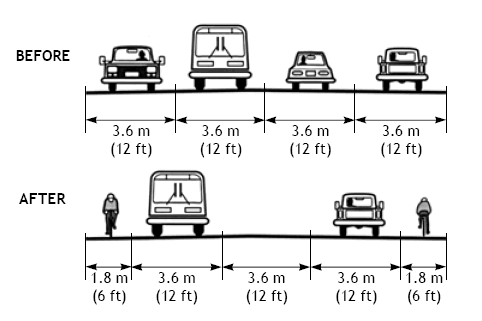Bike Lanes on 23rd Ave: Patience Grasshopper

[ Diagram of a “road diet,” which will be necessary to fit bike lanes on 23rd Ave ]
As previously reported, the City of Seattle’s new Bike Master Plan shows bike lanes on 23rd Ave, south of Madison St. Since 23rd Ave is so narrow, the only way this could happen is if the road loses two motor vehicle travel lanes. But because 23rd Ave is such an important north-south arterial, I have always thought it highly unlikely that the City would follow through on the plan and sacrifice car capacity for bike lanes. There has already been one case in which the plan was watered down, on Stone Way in Fremont.

[ Stone Way bike lane protest ride, August 2007. Photo: Seattle Times ]
My suspicions were aroused upon reading a statement from SDOT posted here that said more analysis would be necessary before a decision would be made on 23rd Ave. In contrast, the bike master plan web site implies that thorough analysis has already been done:
“Relevant city arterial streets, determined by the existing data review and public input were further analyzed for potential addition of bike facilities using GIS (Geographic Information Systems) analysis and field evaluation. This study arterial network was further refined to develop a comprehensive and continuous bicycle network appropriately distributed throughout the City.”
So I fired off an email to SDOT asking for an explanation of why the Bike Master Plan is subject to further analysis, and what the process will be for coming to a final decision. Today, exactly one month later, I got a reply.
The short version is that in some cases SDOT decided to show recommendations that were not yet entirely backed up by traffic analysis, instead of showing nothing at all. Detailed evaluation of 23rd Ave will begin next Fall, and by March 2009, a final decision will be made. SDOT invites community involvement in the process.
In one way, the year-long delay may be a good thing. Because as time passes, public awareness of global warming, peak oil, and the importance of modifying our cities for less reliance on cars will only continue to grow. Ultimately, the decision on 23rd Ave will reveal that either we are coming to grips with future reality, or we are still stubbornly clinging to our car addition.
For the hardcore: full text of SDOT’s response after the break.
Dear Dan:
Again, thank you for your email regarding 23rd Avenue. We appreciate
your interest in implementing the Bicycle Master Plan and thank you for
your patience while I obtained more information regarding your question.
I have some good news to report. Starting this fall, we will begin
evaluating 23rd Avenue for possible lane changes and installation of
bike lanes. By March of 2009, we will make a decision on how to proceed
with the design of the street. We are very eager for your involvement
and will be happy to meet with you and others in your neighborhood
starting next fall.
To respond to your comment about implementing the Bicycle Master Plan
requires some background on the how the plan was developed and how it
will be used as we move forward.
The Seattle Bicycle Master Plan was developed as a joint effort between
the city, representatives of bicycling groups, individual citizens and
Toole Design – the consultant who worked with us to develop the plan.
These different stakeholders were brought together to form a Citizens
Advisory Board (CAB) and have met on a regular basis for more than
eighteen months.
Early on in the process, there was a consensus that the plan should be
as specific as possible in laying out a comprehensive, interconnected
system of bicycle facilities for the city. The desire was to have a
practical plan that could be implemented immediately, some of it even
before formal adoption. Subsequently, Toole Design was directed to
review most of the arterial streets and many of the non-arterial streets
to identify various treatments such as bike lanes, sharrows, climbing
lanes and signed routes. This included possible cross sections,
recommended signing and specific recommendations at key intersections
throughout the city.
One of the challenges inherent in creating this type of plan is that it
creates a series of recommendations that lack a full traffic analysis
and detailed design work. In other words, the plan represents our very
best judgment as to what will work but is still subject to further
study. The other alternative would have been to develop a policy
document without much detail. This was not acceptable to the city or
the other stakeholders.
With this background in mind, I would like to get back to implementing
the Bicycle Master Plan. The assumption will be that the bicycle
facilities, as shown on the Bicycle Master Plan will be implemented. If
we don’t proceed with implementing a particular recommendation as a
result of our traffic analysis, then we will document the reason. In
other words, the burden is on us to explain why we are not doing
something in the plan, not to justify why we are implementing something
in the plan.
Thank you again for your email. Please feel free to contact me if I
can be of additional assistance. I can be reached during normal
business hours at (206) 684-8114.
Sincerely,
Peg
Peg Nielsen
Senior Public Relations Specialist
Communications, Office of the Director
Seattle Dept of Transportation (SDOT)
206-684-8114
